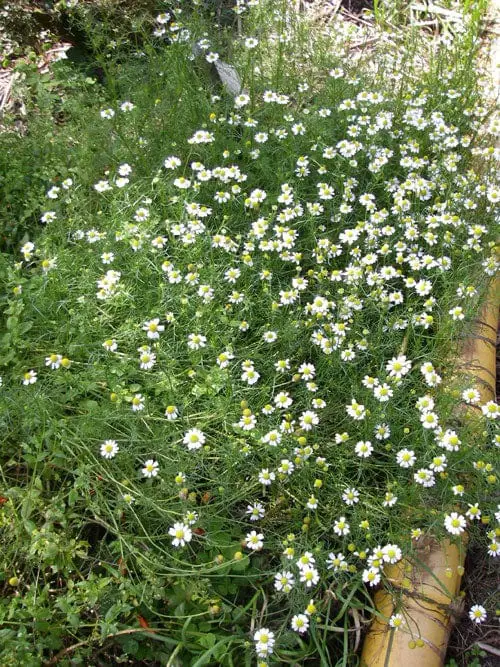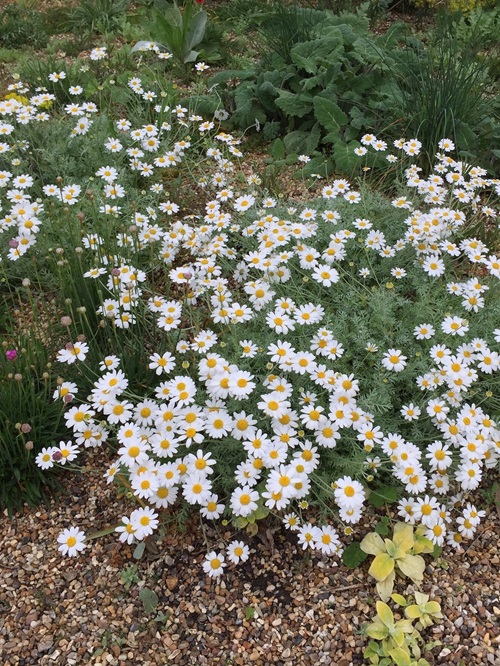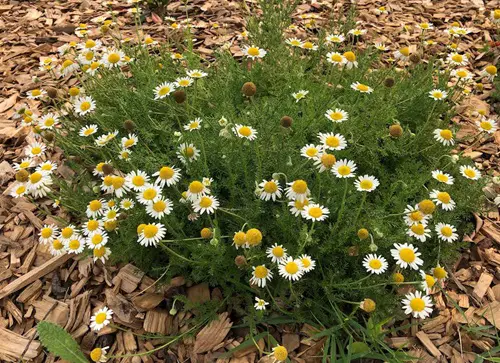Create a Chamomile Border for These Reasons! Find out what else is in store besides an abundant supply of this soothing wildflower.

This fragrant herb softens all the wilderness in any garden with its delicate blooms and leaves and offers many practical benefits. We suggest you grow this wildflower as a garden border for several reasons! Let’s find out.
Chamomile deters pests, attracts pollinators, is used in teas and eatables, and grows even in lawns and meadows, filling the air with its calming scent. Easy to grow and maintain, it is a gorgeous addition to any garden.
How to Create a Chamomile Border
Chamomile is ideal for growing at the front borders in flower gardens, in rock gardens to soften sharp edges, and as an alternative to grass in lawns with less foot traffic. The two options are German or Wild Chamomile with white blooms and Roman or English Chamomile with a dark green creeping foliage mat. Both these varieties are highly fragrant and rich in essential oils.
Roman chamomile (Chamaemelum nobile) is a better option for planting in borders as this perennial grows year after year. On the other hand, German chamomile (Matricaria recutita) is an annual that dies after flowering.
However, Roman chamomile does not grow true from seeds, but it’s better cultivated from division or cuttings; if you don’t have this plant growing already, it is best to buy young plants from garden centers instead.
If you still wish to proceed with seeds–sow them indoors about six weeks before the last expected frost to yield the best germination results. You can also plant seeds in the ground in late fall after the first frost so the seeds can undergo a natural cold stratification.
Sprinkle seeds in trays filled with moist seed compost. Press them gently and keep the temperature around 64-68 F (18-20 C). The seeds will germinate in 7-14 days. When seedlings are big enough to handle, space them by 10-11 inches (25-30cm) and plant them with adequate watering.
USDA Zones for Growing Roman Chamomile
This variety grows best in hardiness zones 4-9. Finding your USDA zone is essential to ensure that your chamomile border will endure the winter and grow throughout the season.
- Zones 4-5: In these zones, the plant will require some winter protection, like mulching to avoid frost damage. It is perennial down to zone 4 and kept outdoors but requires protection from dry cold winds that can even it.
- Zones 6-7: The areas here need less protection, as winters here are not as harsh as the zones suggested above.
- Zones 8-9: This can be categorized as a warmer zone ideal for year-round growth. However, the plant will need some afternoon shade in summer to avoid extreme stress.
Grow Roman Chamomile in Borders
Sunlight
Plant it in a location with full sun to partial shade. Roman chamomile favors full sull and handles some shade in hot climates, i.e., USDA Zones 8-9. A bit of afternoon shade is needed in hot southern areas, as it will save the flowers from drooping.
Soil
It grows best in well-draining, sandy, light, or loamy soil with a pH range from 5.6 to 7.5. Before planting, loosen the soil down to 6 inches deep. Add some compost to refine soil drainage and fertility.
Water
Always keep the soil moist but not waterlogged. When established, chamomile becomes quite drought-tolerant. Allow the soil to dry out between waterings, but don’t forget to hydrate more in extreme heat.
Temperature
Chamomile thrives in 60-70 F (15-21 C). It can withstand cold winters but needs some protection in extreme cold. It grows well in summer as long as the temperature is below 100 F (38 C).
Roman chamomile is hardy in winter, even when it’s freezing, but it cannot tolerate extreme heat and humidity.
Fertilizer
This wildflower is not a heavy feeder. However, you can give it a little boost by applying a balanced fertilizer occasionally.
Pruning
To keep the borders looking neat, trim the plants after flowering. This will coax new growth into sprouting and make it bushier. Prune the plant to about 4-5 inches, boosting lush, compact growth with more blooms.
Spacing
When planting this herb, space it about 8-12 inches apart. For row spacing, leave up to 12 inches between rows; this will provide sufficient air circulation and sun exposure.
Create a Chamomile Border for these Reasons
1. Sweet Smell and Petite Looks
One of the main reasons for growing chamomile on the border is its beauty. The delicate, daisy-like blooms with white petals and yellow centers bloom across the summer and brighten up any space. The apple-like fragrance fills the air, making it ideal for relaxing after a hectic routine.
The aroma of chamomile is most potent when plants are brushed, so a border helps with this. Line it along garden edges or pathways to squeeze out its fragrance.
2. Easy to Maintain

This plant is easy to maintain and perfect for the busy bee. Once mature, it is drought-tolerant, so you only need to pay attention to its watering needs when growing. The best part is chamomile is not finicky about soil, thriving even in poor mediums. And it doesn’t need constant feeding, which thoroughly frees you up.
3. Lures in Beneficial Insects
Another reason to create a chamomile border is that this herb attracts beneficial insects to the garden. Pollinators such as bees and butterflies (monarch butterflies) are drawn to the blooms and help pollinate other plants in the garden. It also attracts predatory insects like hoverflies and ladybugs, which aids in repelling pests such as aphids.
4. Easy to Propagate and Grow
You can propagate chamomile from both cuttings and seeds quickly. After the plant matures, it self-seeds and spreads over time. You can divide mature plants to grow more borders or thicken existing ones. Or pack pretty bunches and send it off to your friends!
5. It’s a Team Player
Chamomile is a great companion to lavender, which you grow in hedges, too. Thyme and rosemary pair well with this wonderful herb. The way it spreads with ease alongside these plants adds texture and dynamics to your landscape.
6. It Repels Pests
This fragrant herb is naturally resistant to many pests, so you don’t need to worry about pest infestation. The scented leaves also repel harmful insects such as mites, carrot flies, mosquitoes, and flies from the garden.
And as a rule, growing herbs, especially native ones, is crucial for a healthy, thriving garden and ecosystem. Check out this article to learn more about native herbs.
7. Chamomile is a Healer
Chamomile has many medicinal uses. You can harvest its blooms and dry them to make a calming tea that helps you sleep better, relieves stress, and improves digestion. A chamomile border is a sure shot for a steady and fresh supply. Even its fragrant leaves can be used for soothing teas and tinctures.
8. Chamomile in the Kitchen

This edible flower has so many uses in the kitchen that it will blow your mind! Apart from the age-old use as a relaxant in the form of tea, it is used to flavor anything and everything—jams, ice cream, risotto, salad dressing, soups, sorbets, and even liqueurs like vermouth! You can check out these amazing recipes if you’d like to give chamomile as an edible a try!
9. Helps Build Sustainable Lawns
We all know how perfectly manicured lawns are resource-intensive and completely unsustainable in light of climate change. But chamomile can change all this! In fact, it is more fetching and healthy than your regular lawn. This perennial plant is a perfect alternative for grass as it spreads quickly and creates a luscious green mat.
Occasional foot traffic won’t damage it either. Its blooms and leaves lend the garden a mild, refreshing apple scent, and if you brush on it, you’ll smell like it, too!




